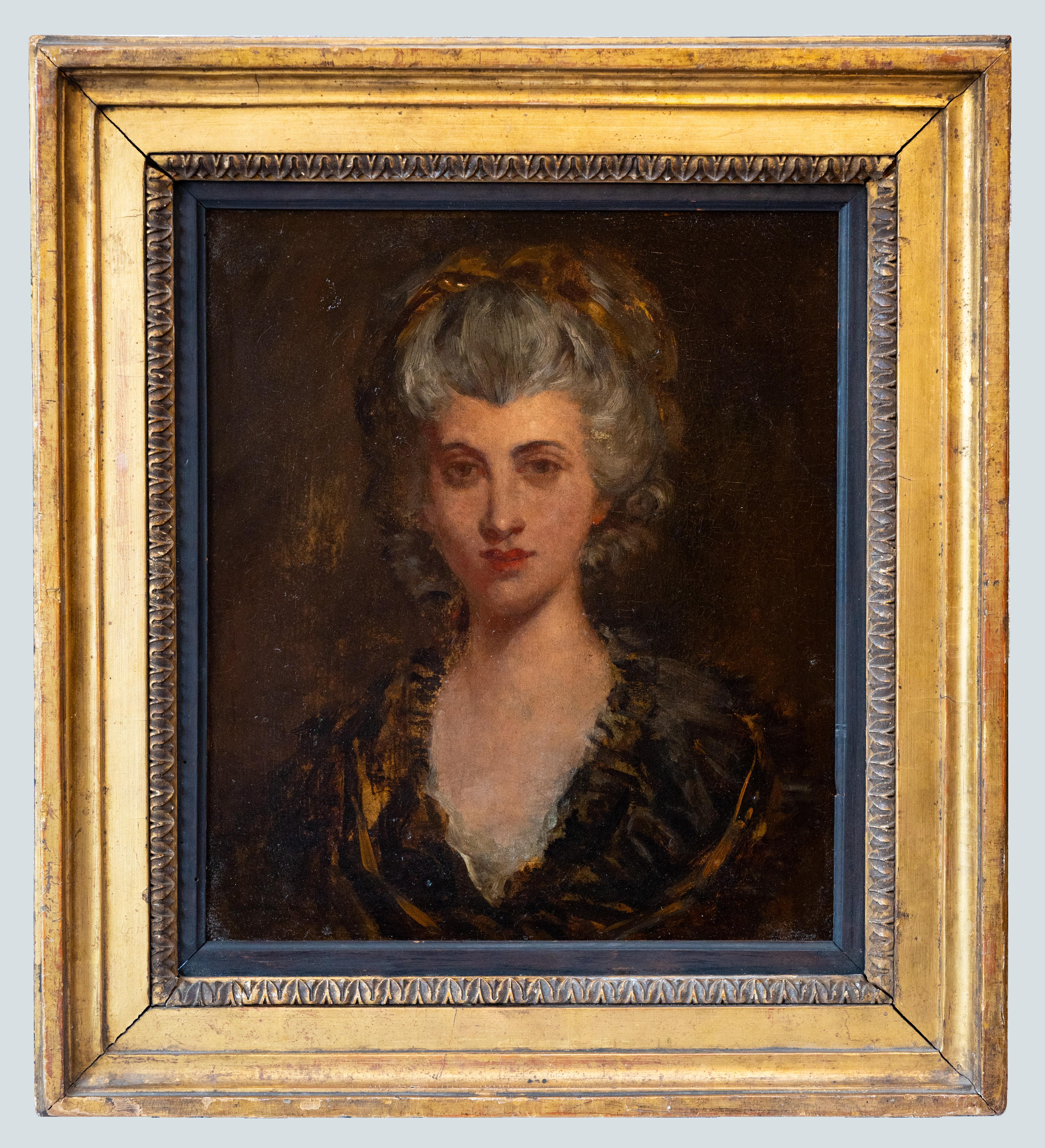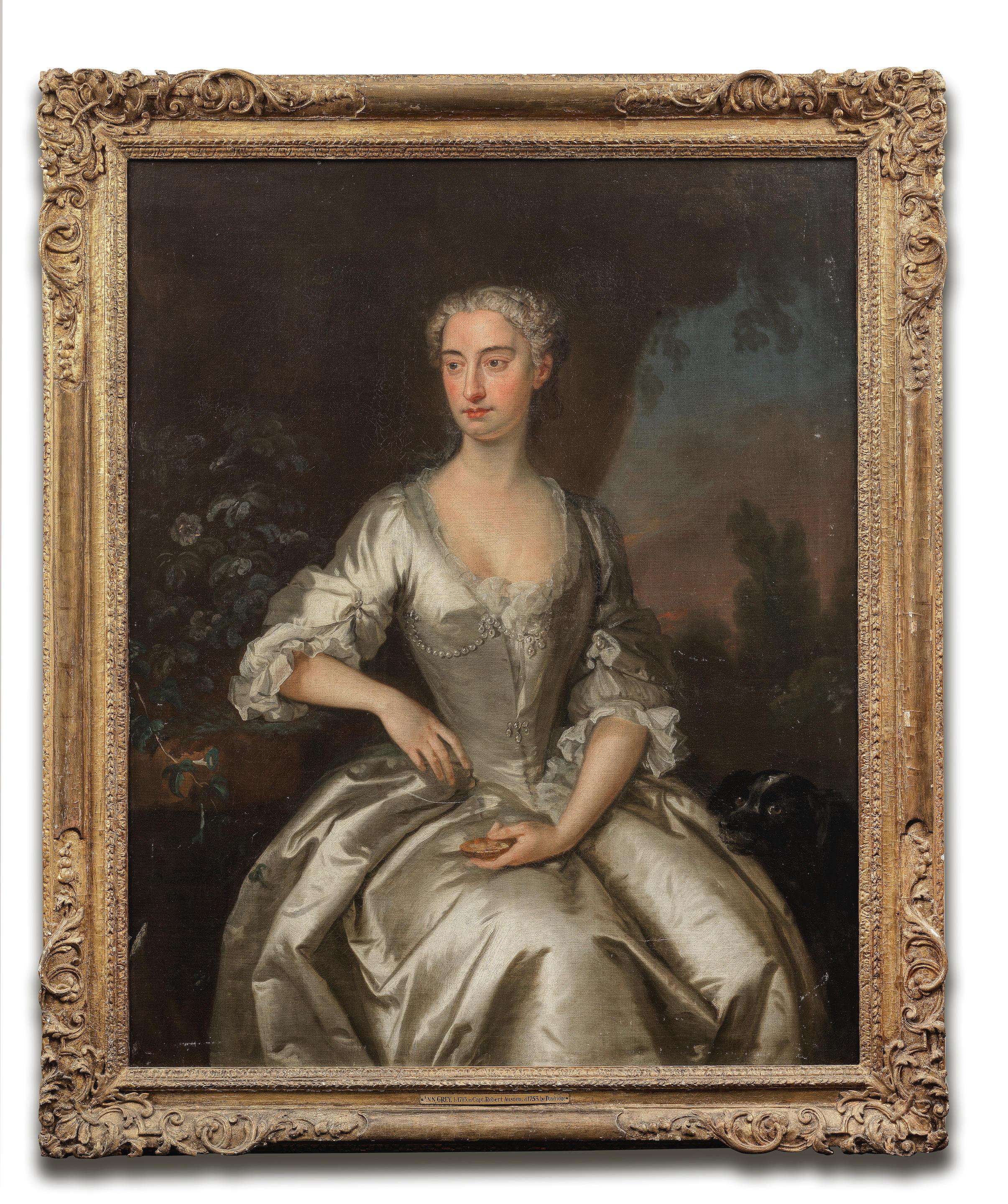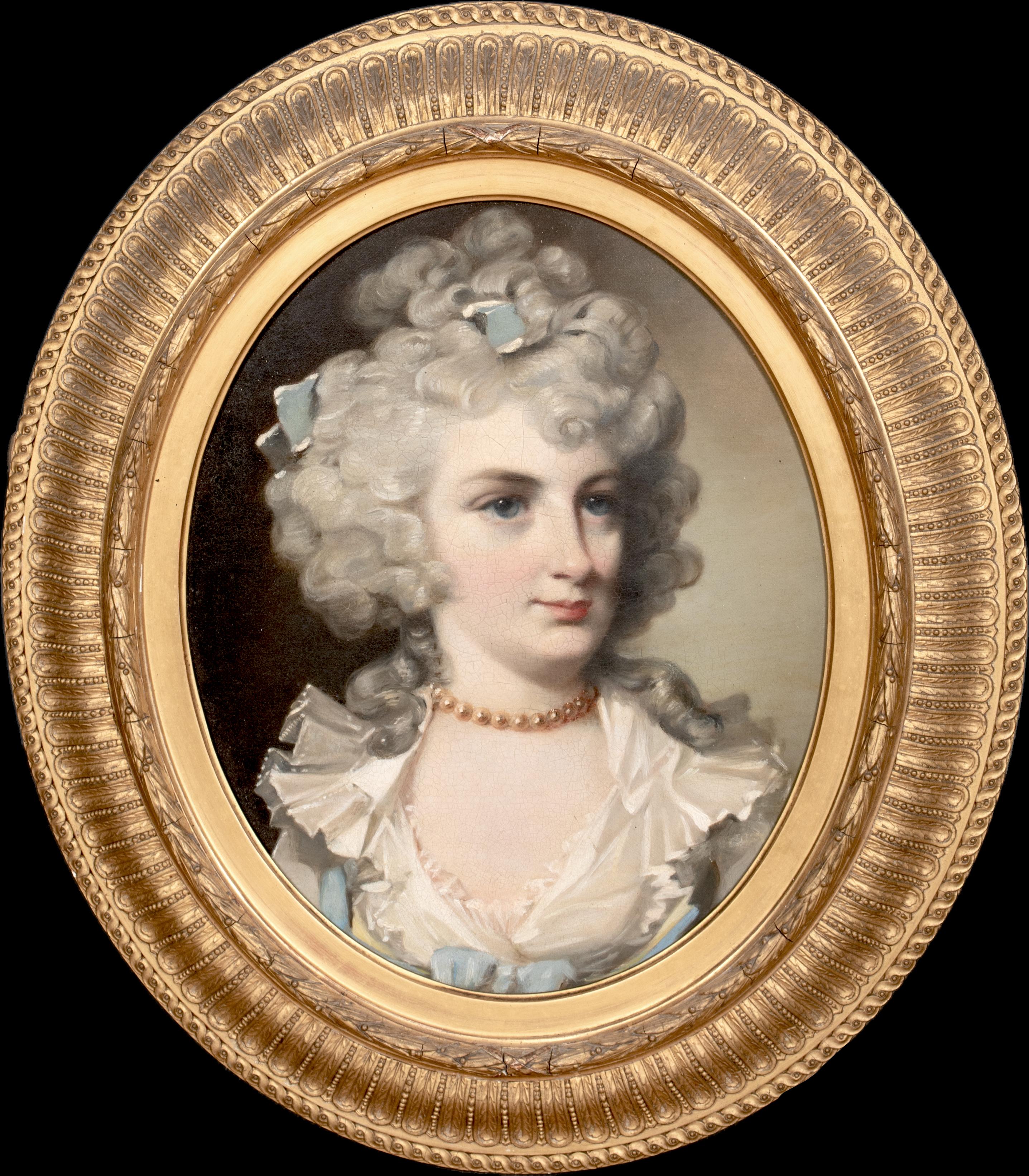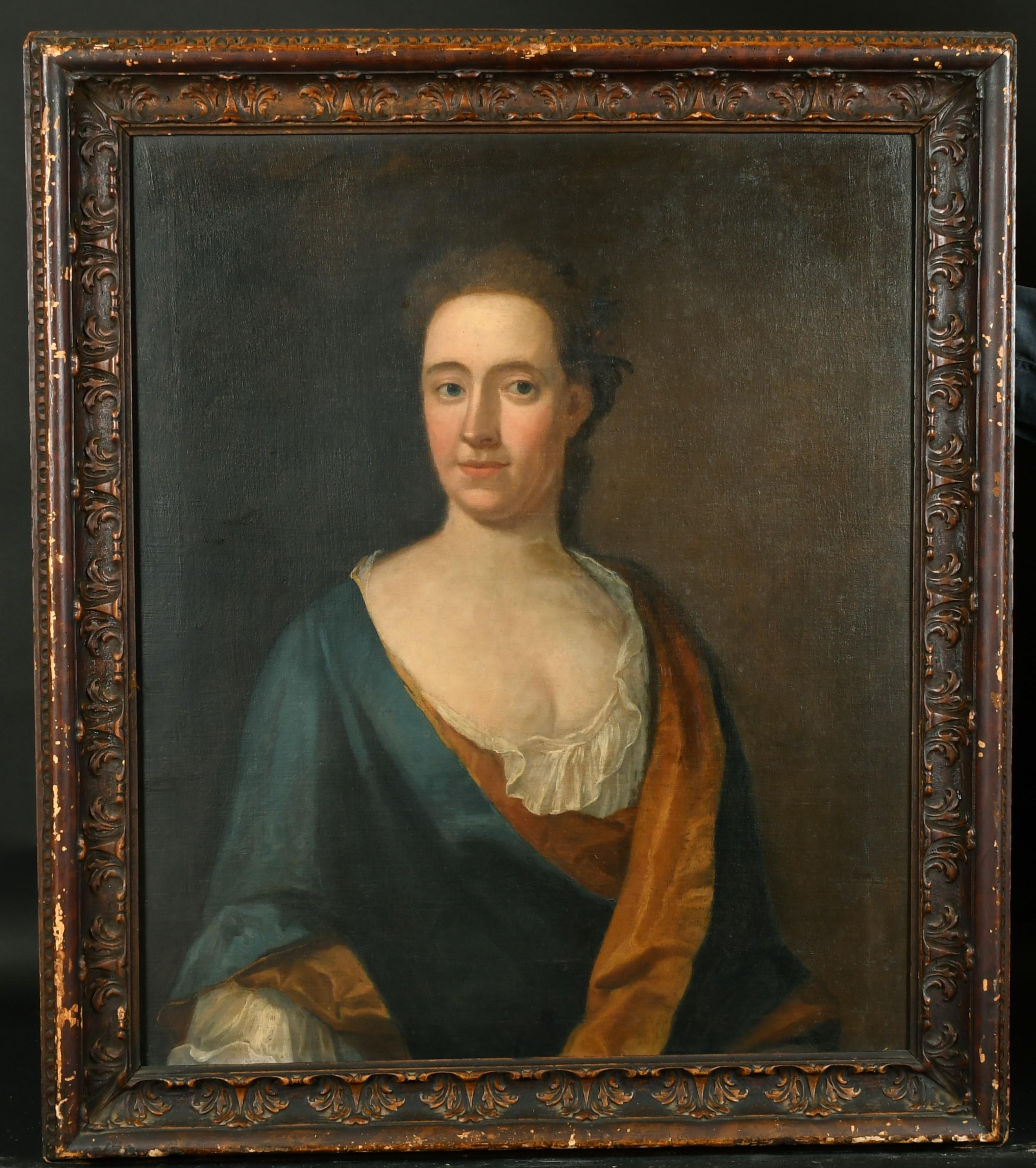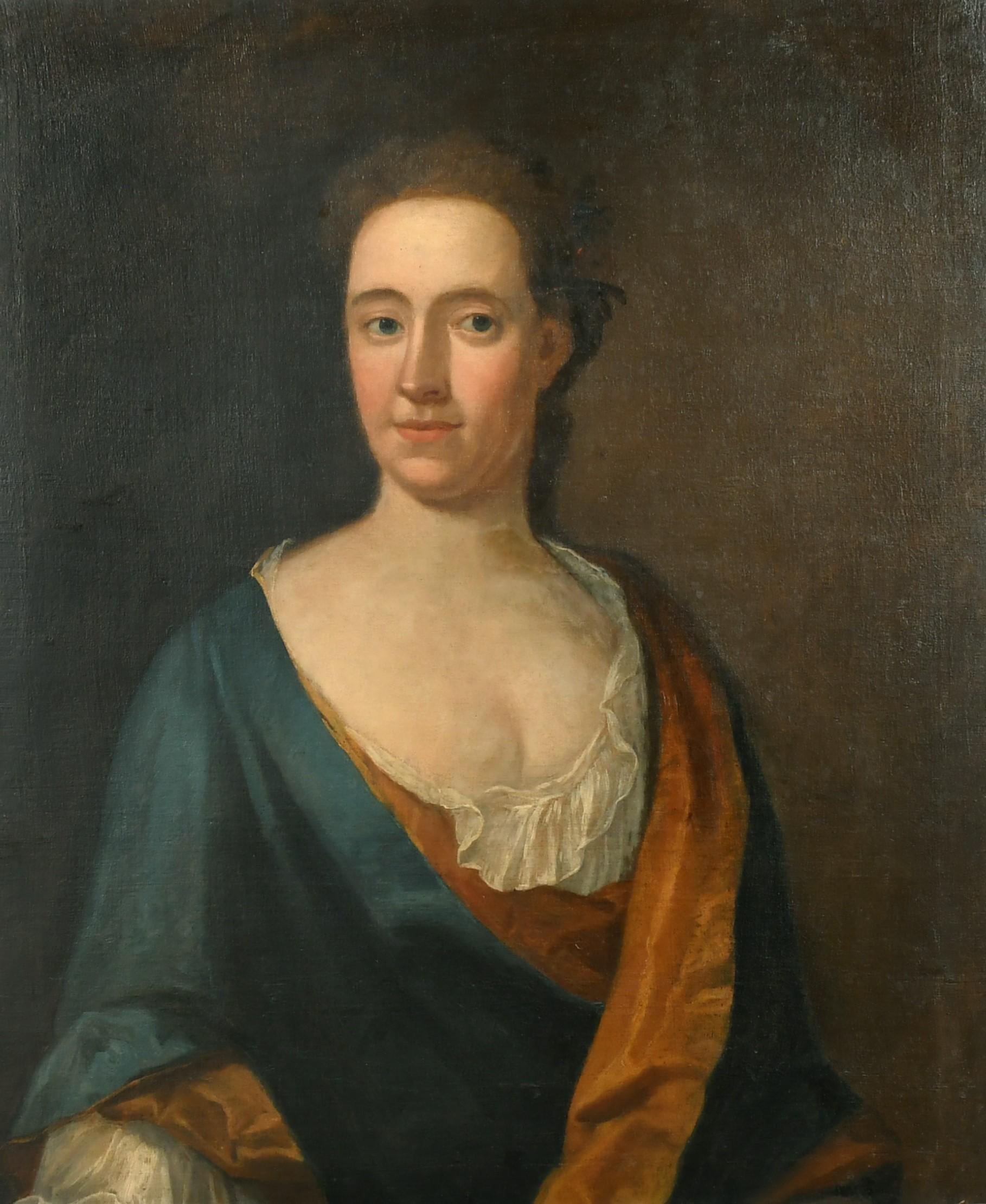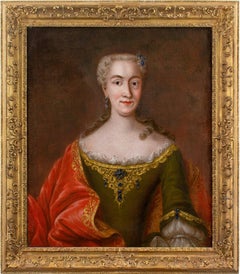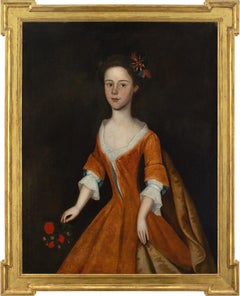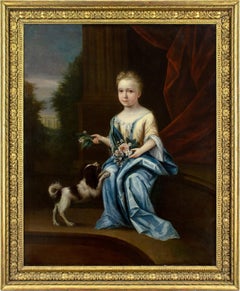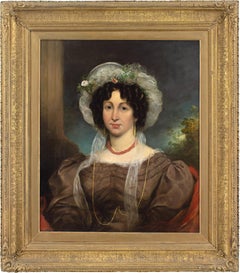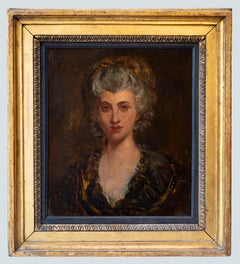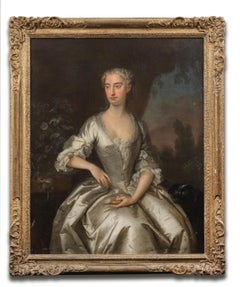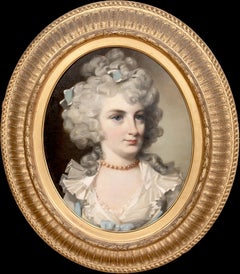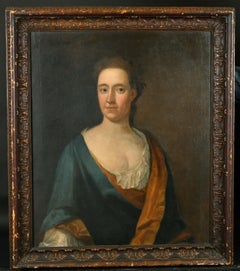Items Similar to Thomas Gainsborough (Follower), Portrait Of Miss Sparrow
Video Loading
Want more images or videos?
Request additional images or videos from the seller
1 of 15
Thomas Gainsborough (Follower), Portrait Of Miss Sparrowc. 1830
c. 1830
$3,616.99
£2,640
€3,084.64
CA$5,035.54
A$5,508.11
CHF 2,879.78
MX$66,346.79
NOK 35,993.26
SEK 33,954.59
DKK 23,026.47
About the Item
This exceedingly charming early 19th-century half-length portrait by a follower of Thomas Gainsborough RA FRSA (1727-1788) depicts a lady traditionally identified as ‘Miss Sparrow’. It’s after the original, which is at the Met Museum in New York and was previously believed to be a study by Gainsborough himself.
Dressed in a blue coat edged with ermine, exquisite ruby and pearl brooch, high powdered hair trimmed with further pearls, and a wrapping gown, she conveys elegance and gentility in abundance. Her outfit dates to circa 1770 and is similar to that worn by Mrs. Thomas Mathews in Gainsborough’s portrait of 1772.
Little is known about Miss Sparrow, as this identification was designated following the publishing of a print in 1870, of which The National Portrait Gallery holds a copy. It’s been speculated that this could in fact be Maria Walpole (1739-1807), the Duchess of Gloucester and Edinburgh, although the likeness is rather slight.
If it is indeed Miss Sparrow, it could relate to the Sparrow family of Ipswich, as Gainsborough produced a portrait of John Sparrow, which is currently at the Auckland Art Gallery. The portrait hung in the ‘Ancient House’, famous for its beautifully decorated plaster façade, until the early 20th century.
Our portrait first appeared on the art market in 1917 at a Christie’s sale relating to the collection of the late Henry Joseph Pfungst (1844-1917), a prolific collector of studies by Gainsborough. It was then acquired by Connell & Sons of London and has since been held by private collectors. At some point between 1917 and 2023, it lost its attribution.
It’s intriguing to consider how this portrait came into existence as, if it’s not a study by Gainsborough, then why is it noticeably different to the original and the engraving? The peculiarities are the eyes, the shading on the right-hand side, the lack of form on the necklace (coupled with its prominence in terms of colouring versus the coat), and the mere suggestion of colour of the coat without further refinement. In addition, on the engraving, Miss Sparrow appears to be wearing jewellery, which can be seen in the ‘niche’ of her hair. This isn’t present on either the original or our copy.
In Hugh Belsey’s catalogue raisonnée (no. 832c), he refers to it as ‘Perhaps British School, 19th Century, Whereabouts Unknown’ having not seen the piece. We’ve tried to contact him for an opinion but with no success.
Either way, copy or study, it’s a fascinating portrait.
Unsigned. Held in a 19th-century gilt frame.
Labels & Inscriptions: A label on the reverse states ‘Study for the portrait of Miss Sparrow, married the Duke of Gloucester’ (which is incorrect). It also refers to the identification being made following consultation with ‘Graves Illustrations of Gainsboroughs, works engraved about 1877’.
Provenance: With Henry Joseph Pfungst (1844-1917) / His posthumous sale (Catalogue of the Collection of Works by Thomas Gainsborough), Christie’s, London, 15 June 1917, lot 77 (as by Gainsborough) / With Connell & Sons, London / Private collection, UK / Auction, London, 2023, UK / Private collection, UK.
Our reference: BRV2130
- Creation Year:c. 1830
- Dimensions:Height: 16 in (40.64 cm)Width: 14 in (35.56 cm)
- Medium:
- After:Thomas Gainsborough (1727 - 1788, English)
- Period:
- Condition:Cleaned. Canvas relined. Areas of fine and settled craquelure, as you would expect. The paint layer is stable. Frame with various marks and showing its age.
- Gallery Location:Cheltenham, GB
- Reference Number:1stDibs: LU2328216314282
About the Seller
5.0
Platinum Seller
Premium sellers with a 4.7+ rating and 24-hour response times
Established in 2017
1stDibs seller since 2023
246 sales on 1stDibs
Typical response time: <1 hour
- ShippingRetrieving quote...Shipping from: Cheltenham, United Kingdom
- Return Policy
Authenticity Guarantee
In the unlikely event there’s an issue with an item’s authenticity, contact us within 1 year for a full refund. DetailsMoney-Back Guarantee
If your item is not as described, is damaged in transit, or does not arrive, contact us within 7 days for a full refund. Details24-Hour Cancellation
You have a 24-hour grace period in which to reconsider your purchase, with no questions asked.Vetted Professional Sellers
Our world-class sellers must adhere to strict standards for service and quality, maintaining the integrity of our listings.Price-Match Guarantee
If you find that a seller listed the same item for a lower price elsewhere, we’ll match it.Trusted Global Delivery
Our best-in-class carrier network provides specialized shipping options worldwide, including custom delivery.More From This Seller
View AllMid-18th-Century French School, Portrait Of A Lady With Sapphires
Located in Cheltenham, GB
This charming mid-18th-century half-length French portrait depicts a lady wearing an olive green gown, together with a red cloak, and exquisite sapphi...
Category
Mid-18th Century Rococo Portrait Paintings
Materials
Oil, Canvas
Mid-18th-Century English School, Portrait Of A Girl With A Posy
Located in Cheltenham, GB
This exceedingly charming mid-18th-century English oil painting depicts a girl wearing a red gown with a train over a white petticoat. She’s holding a posy or nosegay.
Evidently once commissioned for an English country house, the identity of this young lady remains a mystery. Her gown appears to be inspired by the popular ‘robe à la française...
Category
1740s English School Portrait Paintings
Materials
Oil, Canvas
John Verelst (Circle), Portrait Of A Young Lady With A Spaniel
By John Verelst
Located in Cheltenham, GB
This large early 18th-century full-length portrait depicts a seated young lady before a classical column and distant country house. It was formerly in the collection of Dalham Hall i...
Category
Early 18th Century Rococo Portrait Paintings
Materials
Canvas, Oil
George Clint ARA (Attributed), Portrait Of A Lady In A Brown Dress
Located in Cheltenham, GB
This early 19th-century half-length portrait attributed to British artist George Clint ARA (1770-1854) depicts a young lady wearing a beautiful brown dress, bonnet decorated with small flowers, gold earrings and coral necklace. Clint was a distinguished painter and mezzotint engraver predominantly known for portraiture and dramatic scenes.
Set before an evocative classically-inspired backdrop, she looks out from across the centuries with a composed demeanour. Adorned in the latest fashions, oversized ‘gigot’ sleeves, a delicately-poised bonnet, and a coral necklace for good luck. It’s a charming portrayal by a masterful hand.
Born at Drury Lane, in the heart of London’s West End, George Clint was destined to lead an exuberant life amid the spectacle of theatreland. His father, Michael Clint, was a hairdresser during a time of “hair pomatum, whalebone, wire, lace gauze, and feathers” - so young George would have encountered a variety of ‘characters’ during his childhood.
But despite these elevated surroundings, he soon discovered the darker side of London when thrust into the world of employment. Apprenticed initially as a fishmonger, he trained under a ferocious master who was known to beat him. The hours were unsocial, the conditions rank, and the work was brutal. He soon quit but subsequently found himself toiling for a corrupt attorney who demanded he undertake unscrupulous acts on his behalf.
Seeking a less volatile role, he turned next to house painting, at which he excelled. Commissioned, among other projects, to paint the stones of the arches in the nave of Westminster Abbey. Aside from an incident whereby he almost fell from the second story of a building, all was going well.
Following his marriage in 1792 to Sarah Coxhead, a farmer’s daughter, he began work in earnest as a painter of miniatures, determined to forge a career. Robert William Buss’ memoir celebrates Clint’s success as a miniaturist, stating that “great manual excellence was united with that chaste, delicate feeling for female beauty which characterised all Mr. Clint's portraits of ladies.”
Until this point, it appears he was predominantly self-taught, presumably constrained by a lack of finances. But from hereon in, his industrious nature coupled with several fortunate encounters, led to him developing an enviable talent for both painting and engraving. During the early 19th-century, the acquaintances one kept could make or break your fortunes and perhaps acutely aware of this, Clint’s ‘society’ was an ever-evolving circle of influential personalities.
He was “initiated into the mysteries of engraving” by Edward Bell (act.1794-1819) and produced numerous works after the foremost artists, such as George Stubbs, John Hoppner, and Thomas Lawrence. Following a commission from Lawrence, he struck up a long-term friendship.
Admired for his skill as a mezzotint engraver, he sought next to hone his technique in oils and, as with many aspiring portraitists, his first work in this respect was a depiction of his beloved wife. The pair were both delighted with it, yet over time Clint began to doubt himself and sought the validation of a superior hand - that of Sir William Beechey (1753-1839). However, paralysed with insecurity, he couldn’t face the potential criticism, so his wife took it instead - “with a child under one arm and the portrait in the other”. The result was immeasurably more positive than he’d envisaged and he became closely associated with Beechey until his death in 1839.
Numerous commissions followed from the landed gentry including Lord Egremont, Lord Spencer, and Lord Essex. But also from the theatrical community who would fill his studio at 83 Gower Street, Bloomsbury. His connections within the world of acting led to notable works such as ‘Malvolio and Sir Toby’ (from William Shakespeare's 'Twelfth Night', Act II, Scene iii)’ and ‘Harriet Smithson as Miss Dorillon, in Wives as They Were, and Maids as They Are’.
While his efforts in mezzotint included several contributions to JMW Turner’s Liber Studiorum.
As a measure of his success, Clint was elected an Associate of the Royal Academy in 1821 - a position he later relinquished for personal reasons. Today, he’s represented in numerous public collections including at The British Museum, Harvard Art Museums, The Met, V&A, Yale Center for British Art, and the National Portrait Gallery.
“The respect in which he was held, not only by his brother artists, but by an immense number of eminent men in various professions, and others of the highest rank, was the result of a rare combination of talent, candour, suavity of manner, and integrity of purpose”. [Obituary, 1854].
Housed in a period gilt frame, which is probably original.
Learn more about George Clint ARA in our directory.
Labels & Inscriptions: Supplier’s stencil from Rowney & Forster. The National Portrait Gallery holds a database of supplier’s stencils over the decades. The one here is also presented on two other works by George Clint. ‘Falstaff’s Assignation with Mrs Ford...
Category
1830s English School Portrait Paintings
Materials
Oil, Canvas
Maria Verelst (Circle), Portrait Of Miss Richards
By Maria Verelst
Located in Cheltenham, GB
This charming early 18th-century three-quarter length portrait depicts a lady wearing a decolleté blue velvet dress with a slit in the bodice. Red fabric is draped around her, and sh...
Category
1720s Portrait Paintings
Materials
Oil, Canvas
Jacob Huysmans (Attributed), Portrait Of A Lady With Pearls
By Jacob Huysmans
Located in Cheltenham, GB
This splendid mid-17th-century half-length portrait attributed to Flemish artist, Jacob Huysmans (c.1630-1696) depicts a lady wearing a brown and ivory dress decorated with pearls, t...
Category
Mid-17th Century Baroque Portrait Paintings
Materials
Canvas, Oil
You May Also Like
Portrait of a lady, Elizabeth Ann Sheridan (née Linley; Sep 1754 - Jun 1792)
Located in GB
This refined portrait is believed to depict Elizabeth Ann Sheridan (née Linley; 1754–1792), the celebrated English soprano and wife of playwright Richard Brinsley Sheridan. Painted i...
Category
Late 18th Century Portrait Paintings
Materials
Canvas, Oil
Portrait of Ann Austen, nee Grey
By Bartholomew Dandridge
Located in London, GB
Signed 'BDandridge/ pinxit' lower left
Provenance
By descent through the sitter's family to
The Collection of R. W. Vivian-Neal of Poundisford Park, Somerset, from whom acquired by
With Lane Fine Art, UK, where purchased by the present owners in 1996
Literature
'Poundisford Park, Somerset' in Country Life, 22 December 1934, ill.
A.W. and C.M. Vivian-Neal, Poundisford Park, Somerset: A catalogue of pictures and furniture, Taunton 1939, cat. nos. 11 and 13
This is a portrait of Ann Austen, nee Grey, three-quarter-length seated in a landscape with her dog. Painted in a superb white satin dress, she holds horn spectacles and a spectacle case...
Category
Mid-18th Century English School Portrait Paintings
Materials
Oil
Portrait Of A Lady, 18th Century
Located in Blackwater, GB
Portrait Of A Lady, 18th Century
circle of Richard COSWAY (1742-1821)
18th Century English portrait of a Lady, oil on canvas circle of Richard Cosway. Excellent quality and condit...
Category
18th Century Portrait Paintings
Materials
Oil, Canvas
Fine 18th Century British Portrait of an Aristocratic Lady, Large oil painting
Located in Cirencester, Gloucestershire
Circle of Thomas Hudson (1701-1779) British.
18th Century Bust Portrait of a Lady,
Oil on Canvas, Inscribed on a label verso,
canvas: 30" x 25" (76.2 x 63.5cm).
frame: 30 x 25 in...
Category
Mid-18th Century Old Masters Portrait Paintings
Materials
Canvas, Oil
$2,728 Sale Price
20% Off
Portrait of Mrs James Hoste - British 18th century art portrait oil painting
By John Vanderbank
Located in Hagley, England
This superb large three quarter length British Old Master portrait in a landscape oil painting is attributed to circle of John Vanderbank the Younger. Painted circa 1738 the sitter is Mrs James Hoste of South Wootton and Sandringham, nee Hammond. She was the daughter of Anthony Hamond and Susan Walpole, daughter of Robert Walpole, and was sister to Robert, 1st Earl of Oxford. She married Major James Hoste of Sandringham, Norfolk, and they had two daughters. The sheen of her blue satin dress against her gold cloak is stunning. A really lovely 18th century portrait with excellent provenance.
Inscribed with sitter details lower left.
Provenance. By descent within the family of the sitter at West Acre High House, Norfolk;
Cheffins, Cambridge, 'West Acre High House' sale, 24 November 2010, Lot 519; Wood Hall, Arkesden, Essex.
Literature: 'Portraits in Norfolk Houses', Prince Duleep Singh, 1927, No. 36.
Sitter's details on two labels verso.
Condition. Oil on canvas, image size is 50 inches by 40 inches and in good condition.
Frame. Housed in an ornate gilt frame, 58 inches by 48 inches framed and in good condition.
John Vanderbank (1694-1739) was an English portraitist and book illustrator, who enjoyed a high reputation for a short while during the reign of King George...
Category
18th Century Old Masters Portrait Paintings
Materials
Oil
$13,123 Sale Price
20% Off
Fine 18th Century British Portrait of an Aristocratic Lady, Large oil painting
Located in Cirencester, Gloucestershire
Circle of Thomas Hudson (1701-1779) British.
18th Century Bust Portrait of a Lady,
Oil on Canvas, Inscribed on a label verso,
canvas: 30" x 25" (76.2 x 63.5cm).
frame: 30 x 25 in...
Category
Mid-18th Century Old Masters Portrait Paintings
Materials
Canvas, Oil
$2,734 Sale Price
20% Off
More Ways To Browse
Antique Duchess
Pearl Hair
Antique Hair Brooch
Couple Necklace
Painted Birkin
Race Car Painting
Rosie Huntington
Scholar Oil Painting
Spanish Jewish
Terry Shelbourne
Tiziano Vecellio
16th Century Religious Painting
1860 Oil Painting Of Woman In Black Dress
Antique Oil Painting Skull
Antique Oil Portrait Child
Bernardino Campi
Consuelo Vanderbilt
David Alison
